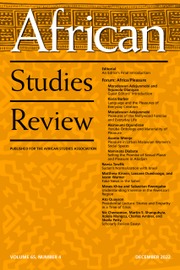University campus life in Africa presents a paradox. On one hand, it is a place of unbridled freedom from parents, guardians, and “sponsors,” but on the other hand, it demands structure and rigor. Usually, students assume different personas, while navigating the perils of finding a balance between new-found liberties and the rigors of academic life. Bocast’s If Books Fail, Try Beauty offers a Makerere, Ugandan, and East African case study of this paradox.
The title, If Books Fail, Try Beauty, is based on a derogatory expression that alludes to a Kiganda and colonial worldview in which there exist “a fundamental dichotomy about gendered personhood in Uganda,” and women are deemed incapable of rational thought “while men are considered steadfast and wise” (xxvi). Furthermore, an imaginary of the philandering female student engaged in sexual exchange tied to “comfort” and middle classness, precludes her from higher education. Thus, the words “educated” and “womanhood” are incompatible. The book is structurally organized around three interdependent parts titled “Orientation,” “Embodiment,” and “Departures.” Orientation (Part I) crisply introduces paradoxes, concepts, arguments, methods, and historical contexts to readers while Embodiments (Part II) investigates educated womanhood as a site of contention between tradition and modernity, and the changes wrought by neoliberalism. Finally, Departures (Part III) takes a longue durée perspective on educated womanhood (from primary through tertiary, and beyond), realizing “how gendered dynamics of patron-clientelism undergird the experiences of all young women in Uganda” (27).
Bocast’s book foregrounds expressions of womanhood, personhood, and sexuality in Uganda’s patriarchal and colonial pasts, as well as its neoliberal present. At a more intimate level, If Books Fail, Try Beauty shows how these have shaped expressions of womanhood, personhood, and sexuality among Makerere University students. This book argues that Uganda’s neoliberal turn, which was highlighted by measures such as deregulation of the economy and liberalization of the market, intersected with “everyday interactions to produce a thriving sexual economy at Makerere University” (142). On campus and away from kin, students invented “new worlds in the open space of campus life” (6). In the quotidian details of everyday campus life, female students exchanged sexual favors for money, electronics, academic grades, nights out with friends, houses, and the future promise of employment. Bocast stresses that the commodities that female students acquired through Makerere’s sexual economy were “valued not just for their economic worth, but for their embodiment of skill at the ‘game’” (80). The “game” is a euphemism for one’s ability to coordinate relationships with several men. This enactment of promiscuity evoked the word “spoiled,” a term used for girls and women who are deemed morally bankrupt, and who defy models of respectable behavior. The central paradox in the narratives on Makerere female students is that they are “financially stable … yet engage in practices that put them at risk …” (3). On the other hand, Makerere’s patriarchal biases find expression in “institutionalized systems of patron-clientage” that male students take advantage of “on their way to positions of power on the national stage” (72).
The book is beautifully written, and easy to follow, as the author navigates the meandering pathways traveled by the cast of the narrative(s). Through immersion in Makerere University campus life, Bocast relived the lives of women such as Esther, Agnes, Lucy, Pearl, Rachel, and Deborah, as they partook in Makerere’s sexual economy and commodities race. Through collective effort or what the author terms “dependency work,” these women took turns in redistributing their “spoils” among themselves. Additionally, they took advantage of tabloid newspapers to manage their public image and reputation, while simultaneously fending off national and international overtures to control their bodies. Eventually, the story got more complicated for the likes of Rachel, who chose NGO sponsorship over sugar daddy sponsorship. Caught in an international development empowerment discourse initiative, she tried to fulfill her communal obligations while simultaneously exploring individual career ambitions. Indeed, Rachel’s life story illustrates how “young people confront intensifying moral conflict amidst the shifting landscapes of individual potential and collective obligation wrought by neoliberal reforms” (144). In the end, she sacrificed her individual career goals because the sponsorship required her to go back home to help develop the community.
For graduate students, this book offers a lesson on the research and writing process. To begin with, there is a clear discussion of the author’s methodology in data collection and analysis. Through an ethnographic approach, the researcher stage-manages the meandering and seemingly unrelated stories into a narrative that tells the story of the female students of Makerere University. Conceptually, this book goes beyond the classic Marxist (materialist) approach to class analysis to the “symbolic and performative dimension of social class.” More importantly, it shifts attention from the favored “lower classes” to the new middle classes “as an analytic and as actual people worthy of study” (8). This, she labelled as “studying up” (24).
Although this book is the story of Makerere, it also represents a neoliberal reading of the political economy of higher education, and institutional cultures prevalent in universities across the continent. If Books Fail, Try Beauty is indeed a timely addition to the historiography on the university in Africa.


